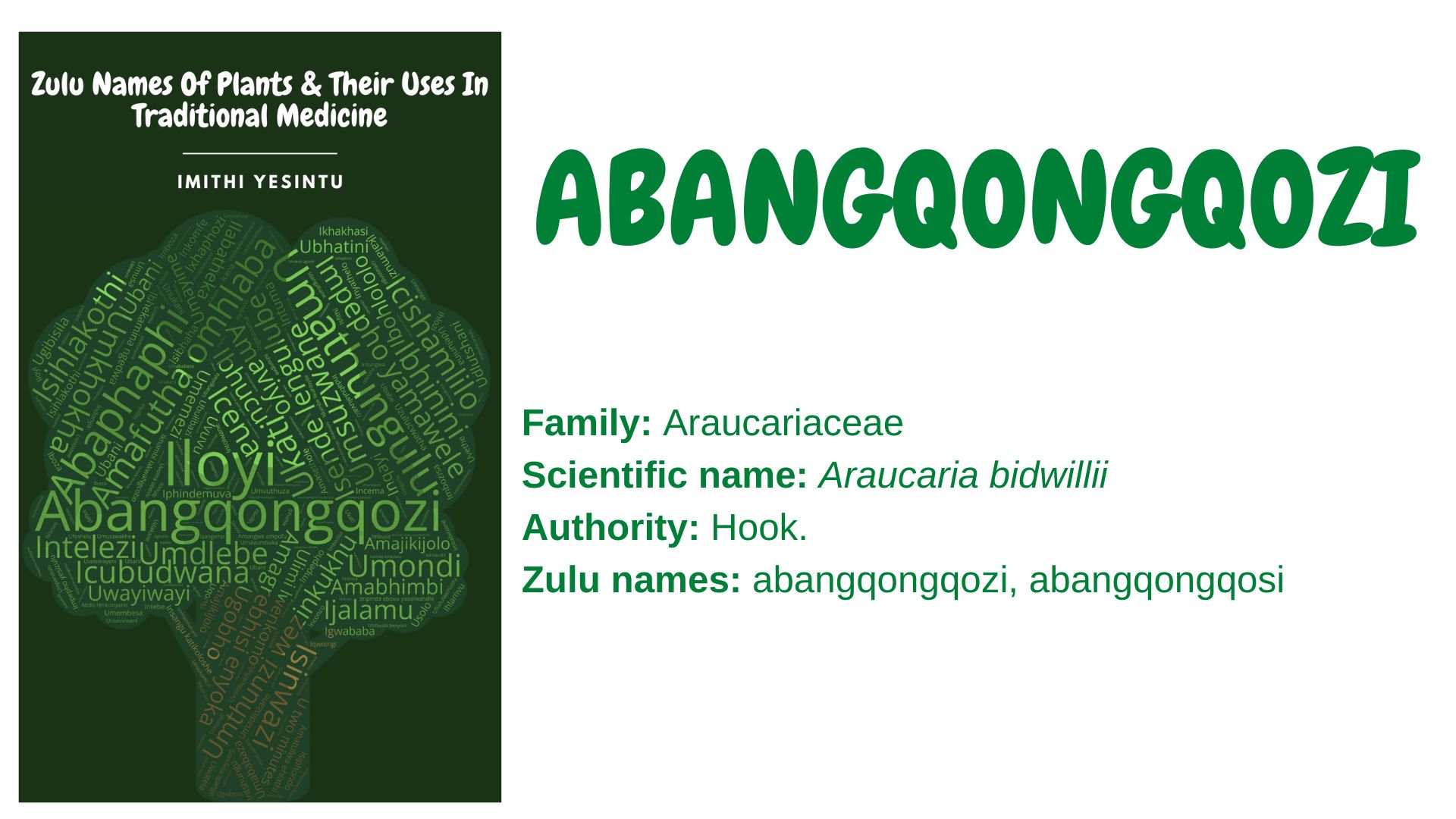Family: Araucariaceae
Scientific name: Araucaria bidwillii
Authority: Hook.
Synonyms: Araucaria bidwillii var. pendula Van Geert, Columbea bidwillii (Hook.) Carrière, Marywildea bidwillii (Hook.) A.V.Bobrov & Melikyan
Zulu names: abangqongqozi, abangqongqosi
Other names: bunya-bunya, bunya pine, monkey puzzle tree
Plant description: A. bidwillii is a non-native evergreen coniferous (alien) tree that exists in South Africa. It is native to Queensland, Australia. The tree grows to about 50 m in height and exudes resin from the stem.
Uses:
- When young, the tree is used as a Christmas tree.
- The seeds are eaten as raw or cooked nuts.
- The bark is used in ritualistic bathing and steaming. The bark is typically ground to powder and then added to water prior to bathing and steaming.
- The bark is used to treat amenorrhoea. One spoon of the powdered bark is poured into approximately 750 ml of cold water and left for a day. Subsequently, four tablespoons of the mixture is taken orally once a day.
- The bark is used to treat anxiety, insomnia, and mental stress.
- The tree has analgesic properties, hence it is used to relieve pain.
- The tree is used to treat swelling and-or inflammation.
- The tree is cultivated as a garden ornamental.
Safety precaution:
Using traditional medicine responsibly can enhance your overall health and well-being. Misuse and abuse can lead to complications. You can inquire about the correct use of traditional medicine from a knowledgeable herbalist and practitioner. You can also visit imithiyesintu.co.za or email: info@imithiyesintu.co.za to learn more about traditional medicine
References and further reading:
- Aslam, M.S., Choudhary, B.A., Uzair, M. and Ijaz, A.S., 2013. Phytochemical and ethno-pharmacological review of the genus Araucaria–review. Tropical Journal of Pharmaceutical Research, 12(4), pp.651-659.
- Baz, M.M., Khater, H.F., Baeshen, R.S., Selim, A., Shaheen, E.S., El-Sayed, Y.A., Salama, S.A. and Hegazy, M.M., 2022. Novel pesticidal efficacy of Araucaria heterophylla and Commiphora molmol extracts against camel and cattle blood-sucking ectoparasites. Plants, 11(13), p.1682.
- Dold, A.P. and Cocks, M.L., 2000. The medicinal use of some weeds, problem and alien plants in the Grahamstown and Peddie districts of the Eastern Cape, South Africa. South African Journal of Science, 96(9/10), pp.467-473.
- Mukherjee, P.K., Ahamed, K.N., Kumar, V., Mukherjee, K. and Houghton, P.J., 2007. Protective effect of biflavones from Araucaria bidwillii Hook in rat cerebral ischemia/reperfusion induced oxidative stress. Behavioural Brain Research, 178(2), pp.221-228.
- Picone, A.P., 2015. Habitat, population structure and the conservation status of Araucaria bidwillii Hook. in the Australian Wet Tropics (Doctoral dissertation, James Cook University).
You Can Order Your Copy Of The Book By Emailing: info@imithiyesintu.co.za
Feel Free To Add Other Uses Of This Plant In The Comment Section Below:
